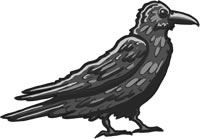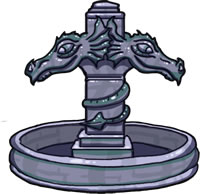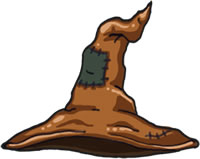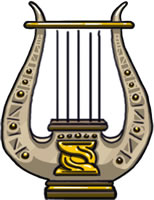The Artifacts
There are 9 types of artifacts…
Magical Creatures (Signified by the raven)
 Items in this category all share two distinct traits: they are alive and magical. Living, breathing creatures that are aware of their surroundings in varying degrees, these magical beasts are considered a great prize to any collector. Beginning curators are encouraged to research the environmental and dietary needs of their newly acquired creatures, as neglect is universally despised, not mention dangerous to inflict upon creatures with magical powers. Seasoned curators should clean their exhibit spaces at regular intervals and always prior to a new acquisition. It is always a good idea to consider acquiring these animals in groups, as fully sentient creatures tend to become bored without company.
Items in this category all share two distinct traits: they are alive and magical. Living, breathing creatures that are aware of their surroundings in varying degrees, these magical beasts are considered a great prize to any collector. Beginning curators are encouraged to research the environmental and dietary needs of their newly acquired creatures, as neglect is universally despised, not mention dangerous to inflict upon creatures with magical powers. Seasoned curators should clean their exhibit spaces at regular intervals and always prior to a new acquisition. It is always a good idea to consider acquiring these animals in groups, as fully sentient creatures tend to become bored without company.
Queen Mab’s Consort
While normal in appearance this crow is anything but ordinary. Rumored to be hundreds of years old, the Consort is much sought after for its power as a familiar and its ability to enhance the effects of any spell its controlling wizard may cast. Legend says the Consort started out a man in love, but in the end, he failed his fairy partner and was cursed by her as a result. The curse doomed the man to forever wander the earth in the guise of a crow, his fate to serve any wizard strong enough to command his loyalty.
Spell Books and Ancient Tomes (Signified by the book)
 These books are the life’s work of many wizards. While not a strict requirement to being a mage, it is considered a waste not to put one’s years of knowledge, both magical and mundane, onto paper, kept safe for later generations. Most wizards are long-lived and their knowledge cannot be contained in one small volume. Some collectors spend their whole lives trying to piece together the missing volumes of an ancient loremaster’s library. Many never achieve this goal. New collectors often begin their careers by accident after happening upon one of these books and becoming enamored with the thought of finding all the volumes. It goes without saying that any collector should prepare the necessary protections to properly handle any spell books before adding them to an exhibit.
These books are the life’s work of many wizards. While not a strict requirement to being a mage, it is considered a waste not to put one’s years of knowledge, both magical and mundane, onto paper, kept safe for later generations. Most wizards are long-lived and their knowledge cannot be contained in one small volume. Some collectors spend their whole lives trying to piece together the missing volumes of an ancient loremaster’s library. Many never achieve this goal. New collectors often begin their careers by accident after happening upon one of these books and becoming enamored with the thought of finding all the volumes. It goes without saying that any collector should prepare the necessary protections to properly handle any spell books before adding them to an exhibit.
Paedrig’s Book of Abundance
This tome contains many useful spells created and perfected by the earth wizard Paedrig. Primarily a collection of spells used to grow and nurture life, this book still holds incantations too dangerous for novices. As such Paedrig placed powerful spells upon the book in order to hide it from those who sought to posses it for purposes contrary to his own. Unfortunately, Paedrig did a bit too good of a job protecting the book, and he himself lost possession of it. Now the book travels from wizard to wizard, seeming to test each in turn before moving on, always searching for one worthy of its secrets.
Enchanted Works of Art (Signified by the fountain)
 Some wizards and especially talented artisans take it upon themselves to create beautiful works of art, endowed with some sort of magical property. Most collectors and curators prefer to keep these items as the center or showpiece portion of their exhibits due to the magically enhanced displays these pieces usually possess. It has been reported that some of these artifacts were created not as works of art, but as cleverly disguised magical defenses. New and seasoned collectors alike should be on the lookout for these potentially dangerous forgeries, and it is suggested that an expert be called upon to inspect the item before acquisition.
Some wizards and especially talented artisans take it upon themselves to create beautiful works of art, endowed with some sort of magical property. Most collectors and curators prefer to keep these items as the center or showpiece portion of their exhibits due to the magically enhanced displays these pieces usually possess. It has been reported that some of these artifacts were created not as works of art, but as cleverly disguised magical defenses. New and seasoned collectors alike should be on the lookout for these potentially dangerous forgeries, and it is suggested that an expert be called upon to inspect the item before acquisition.
The Fountain of the Dragon’s Lament
Thought to share its powers of health and good fortune with those who bathe in its waters, this fountain is an exquisite example of craftsmanship and design. At one time the fountain sat in Temple Square, a place of rest and meditation for pilgrims traveling from all corners. Now the fountain is the sole possession of a wealthy nobleman whose gambling habit is quickly getting the best of him. Some say the fountain is for sale, its supposed properties available to any who can pay the price.
Magical Apparel (Signified by the wizard’s hat)
 Hats, cloaks, gloves, belts, and even stockings all belong to this illustrious category. Legend would have us believe that all magical pieces of clothing came from one of three magical bolts of cloth created at the time of magic’s inception. The odds of this being truth are slim, but it does go a long way to explaining why the predominant color of most magical clothing is brown. Those collectors that fancy themselves on the cutting edge of display technology have started to find inventive ways of showing off their wardrobes magical clothing. Usually this entails straw-stuffed manikins set up to recreate elaborate scenes where the items are in use in such ways as to show them in the best light possible.
Hats, cloaks, gloves, belts, and even stockings all belong to this illustrious category. Legend would have us believe that all magical pieces of clothing came from one of three magical bolts of cloth created at the time of magic’s inception. The odds of this being truth are slim, but it does go a long way to explaining why the predominant color of most magical clothing is brown. Those collectors that fancy themselves on the cutting edge of display technology have started to find inventive ways of showing off their wardrobes magical clothing. Usually this entails straw-stuffed manikins set up to recreate elaborate scenes where the items are in use in such ways as to show them in the best light possible.
Dallan’s Thinking Cap
Created by the wizard Dallan the Wise, this hat was used to assist him in remembering all the unique ideas he believed he had come up with throughout the day. At first, Dallen found the hat extremely useful, and saw that it performed its intended task quite admirably. However, once he took the hat off, he discovered that all the knowledge he had gained while wearing it was lost to him—gone as if he had never thought such things at all. He soon parted with the hat, thinking it better to remember what he could on his own than to be stuck with last year’s fashion for the rest of his life.
Legendary Items (Signified by the lyre)
 Without a doubt this is the single most important and possibly powerful set of artifacts known. All of the items in this category are considered near mythical in origin and the enchantments laid upon them are powerful in the extreme. These are the most expensive items to collect, given their unique natures. Their acquisition usually signals the fulfillment of a curator’s dreams, the completion of a lifetime’s worth of searching, culminating in an exhibit no other can claim to posses.
Without a doubt this is the single most important and possibly powerful set of artifacts known. All of the items in this category are considered near mythical in origin and the enchantments laid upon them are powerful in the extreme. These are the most expensive items to collect, given their unique natures. Their acquisition usually signals the fulfillment of a curator’s dreams, the completion of a lifetime’s worth of searching, culminating in an exhibit no other can claim to posses.
The Bard’s Best Friend
Crafted by elven artisans skilled in the shaping of wood, these instruments are designed to weather the harsh environments and long journeys which bards must endure to spread their particular type of magic and music across the realms. When kept well, cherished, and played by talented musicians of pure heart, the Bard’s Best Friend will never fail to be in tune, will never suffer the ill effects of wet weather, and will produce the most beautiful and sometimes haunting tones heard by mortal ears. At present time, there are rumored to be only twelve currently in use across the land. Possession of one of these instruments would be a boon to any collector or musician currently in the market to buy.
Dangerous Magic (Signified by the orb)
 It goes without saying that the items in this category should be handled with caution or not at all. Though it never seems to stop the most driven wizards, many different types of artifacts can be extremely dangerous to their collectors; some appear as mundane things found in almost every home, while most are obviously sinister and inspire fear and trepidation just from standing in their presence. Whatever their appearance or the reason for their creation, it cannot be stressed enough that all caution should be taken when collecting and studying these artifacts. Curators seek and keep dangerous magic at their own risk.
It goes without saying that the items in this category should be handled with caution or not at all. Though it never seems to stop the most driven wizards, many different types of artifacts can be extremely dangerous to their collectors; some appear as mundane things found in almost every home, while most are obviously sinister and inspire fear and trepidation just from standing in their presence. Whatever their appearance or the reason for their creation, it cannot be stressed enough that all caution should be taken when collecting and studying these artifacts. Curators seek and keep dangerous magic at their own risk.
The Orb of Things Best Forgotten
No one knows this particular artifact’s history, who found it, or even how it came into being. Still, it is here now and it has things to share with any who dare gaze into its depths. Until recently, the orb was thought to be contained at the Wizard’s College, but if the whispers of the students are to be believed, this artifact has disappeared from the college and has yet to turn up in any known wizard’s collection. If any word on the whereabouts of the orb is discovered, make all haste to report it to the Dean of Magical Mischief at the Wizard’s College before any mishaps may befall you.
Staffs (Signified by the staff, of course)
 As with spell books, it is common for a Wizard to create a magical staff used to make her life and studies more manageable. Some of these staffs are created with small uses in mind such as the ability to provide light; others are used as weapons or personal protection devices. It is even rumored that some Wizards imbue their staffs with magically created intelligence, using them in place of a more traditional familiar. Whatever the reason for their creation, all of these staffs are useful in some way and much sought after by collectors and rival Wizards alike. Curators should endeavor to keep these items, easily mistaken as common walking sticks, out of easy reach.
As with spell books, it is common for a Wizard to create a magical staff used to make her life and studies more manageable. Some of these staffs are created with small uses in mind such as the ability to provide light; others are used as weapons or personal protection devices. It is even rumored that some Wizards imbue their staffs with magically created intelligence, using them in place of a more traditional familiar. Whatever the reason for their creation, all of these staffs are useful in some way and much sought after by collectors and rival Wizards alike. Curators should endeavor to keep these items, easily mistaken as common walking sticks, out of easy reach.
The Staff of Command
This magical staff makes wizards into mighty generals whose charisma and leadership qualities are magnified ten times. Used in the last Wizard Wars, these masterworks have all been lost or destroyed over the years since, save one staff recently discovered in an excavation site far to the east. Soon after the discovery, the staff was lost again, thought stolen, and discretely sold to an unknown buyer. Many fear that the staff will not remain lost for long, but will instead end up in some warlord’s hands. Others believe the staff will end up in a private collection, hidden away and presumably kept safe by one who probably does not know what he truly possesses.
Forgotten Relics (Signified by the statue)
 These items are typically associated with the worship of some deity lost to the memory of any society found in present time. Most are safely locked away in remote monasteries or well guarded temples, but a few are lost in the world, passing from one owner to the next by assuredly improper means and through unscrupulous channels. No matter how the item is acquired, any collector should be aware of the potential danger she suffers from vengeful gods looking to recover lost gifts given to faithful mortals for purposes unfathomable. Some collectors take comfort in hiring a priest or religious expert to inspect the item and certify it safe — or lay protections upon it — before finalizing an acquisition.
These items are typically associated with the worship of some deity lost to the memory of any society found in present time. Most are safely locked away in remote monasteries or well guarded temples, but a few are lost in the world, passing from one owner to the next by assuredly improper means and through unscrupulous channels. No matter how the item is acquired, any collector should be aware of the potential danger she suffers from vengeful gods looking to recover lost gifts given to faithful mortals for purposes unfathomable. Some collectors take comfort in hiring a priest or religious expert to inspect the item and certify it safe — or lay protections upon it — before finalizing an acquisition.
Icon of the Muse
This tiny, carved statue depicts the muse; a minor deity worshiped by long forgotten civilization. Though little is known of these people and their culture, it has been discovered that the Muse was a god of creativity and art, and his followers were some of the most prolific and successful artists and inventors of their time. While not truly magical in nature, the statue is still thought to inspire any who possess it to fits of creativity and impulse that often times result in beautiful works of art or innovations that truly inspire change.
Arms and Armor (Signified by the crossed sword and axe)
 As the name implies, this category encompasses all weapons and pieces of armor that are magical in nature. Collectors and curators should take special note of any requirement needed to safely keep such items on display or locked away in private collections. It should also be noted that some items in this category display some level of sentience. As such, special care must be taken to insure that these items are well socialized and kept with others of their particular disposition. The beginning curator would do well to consider starting her collection with a few small pieces from this category, and seasoned collectors are always happy to round out a display with an enchanted sword or three.
As the name implies, this category encompasses all weapons and pieces of armor that are magical in nature. Collectors and curators should take special note of any requirement needed to safely keep such items on display or locked away in private collections. It should also be noted that some items in this category display some level of sentience. As such, special care must be taken to insure that these items are well socialized and kept with others of their particular disposition. The beginning curator would do well to consider starting her collection with a few small pieces from this category, and seasoned collectors are always happy to round out a display with an enchanted sword or three.
Micah’s Lucky Armaments
Legend would have you believe that these are the actual weapons used by Micah himself as he vanquished all those sent by the Wicked Enchantress to destroy him. Supposedly the blades of these weapons are ever sharp, never suffering the effects of use in battle, and those that wield them will always strike true, seeming to anticipate their opponent’s parries and attacks. Whether the legend is true or not, there is no arguing that the weapons are old and made of high quality materials by gifted craftsmen. These qualities alone make them desirable for any arms collector.